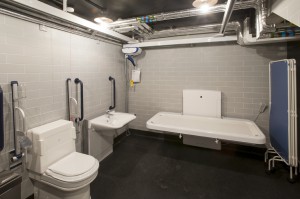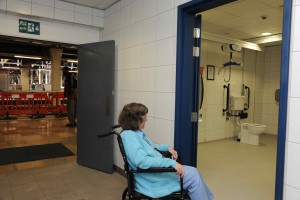Robin Tuffley, marketing manager at Clos-o-Mat, examines why we should provide better accessible toilets…
How often do you go the loo in a day? The average is up to eight times! Imagine how that impacts on your daily life if you need help to carry out this most basic personal hygiene.
Inclusivity and accessibility have been ‘buzzwords’ for a while in any building design, but they are being given new impetus: BS8300:2009- design of buildings and their approaches to meet the needs of disabled people- code of practice, lays down a whole new standard for toileting provision in any building where there are lots of people- from student accommodation to public and civic environments- a code of which many people are unaware.
The Standard follows on the heels of the Department for Communities & Local Government’s ‘Improving Public Access to Better Quality Toilets- a Strategic Guide’, in which a key recommendation is that local authorities make appropriate provision for disabled public toilets, and establish specialist disabled toilets in major centres of population. Baroness Kay Andrews observes in the Guide ‘a lack of accessible and good public toilets affects not only the quality of our town centres…it also reduces the dignity and quality of people’s lives. After all they are one of the basic facilities that residents and visitors alike depend on.’ Her views are reinforced by a survey by Help the Aged, which found many people make a conscious decision NOT to visit somewhere if they believe they cannot find a suitable public toilet.
The need for accessible/ disabled toilets is clear: 10.5m people ie 1 in 6 of the UK population have limiting illness which impinges on their ability to carry out daily life- including going to the toilet. Some 20million are affected by bladder and bowel continence. Research shows ¼ million people including those with profound and multiple learning disabilities and a range of other physical disabilities cannot use standard accessible (Document M compliant) toilets because they need support from one or two carers, or need changing. The Government’s Office for Disability Issues has a vision that by 2025, disabled people in Britain should have the same opportunities and choices as non-disabled people to improve their quality of life and be respected and included as equal members of society.
BS8300:2009, and the Building Regulations Approved Document M 2013 include as ‘desirable’ a whole new concept- Changing Places toilets. These involve the creation of larger, better equipped accessible toilets compared to conventional accessible Document M versions, which only address the needs of someone who can toilet unaided. Each Changing Places toilet aims to meet the needs of people who need a carer to assist, and provides as a minimum:
- The right equipment ie a height adjustable adult sized changing bench, height adjustable wash basin, shower and shower seat, and track or mobile hoist system
- Enough space, to enable maneuvering for the disabled person and up to two carers, for a centrally located (peninsular) toilet with room either side for carers, and a screen or curtain to allow some privacy
- A safe and clean environment, ie wide tear off paper to cover the bench, a large waste bin and a non-slip floor.Changing Places toilets being included into the Standard and the new Document M is a result of the ongoing campaign by the Changing Places consortium to support the rights of people with profound and multiple learning disabilities to access their community. The Consortium comprises the Centre for Accessible Environment, PAMIS, MENCAP, Nottingham City Council, Dumfries & Galloway Council, Valuing People Support Team and the Scottish government. To date, since the Changing PLaces toilet’s inception, some 500 have been installed across the UK
Clos-o-Mat- the UK’s leading supplier of disabled toileting solutions- has produced an informative white paper: ‘Considerations & Specification of Changing Places Accessible Toilets’. The white paper covers all requirements for compliance in one place, and can be downloaded direct from Clos-o-Mat’s website www.clos-o-mat.com.
Clos-o-Mat, founded 50 years ago, is the only company in its field with the in-house capability and expertise to design, supply, install, commission and service all the equipment for a hygiene room/Changing Places toilet, from grab rails through hoists and height adjustable basins to automatic (‘wash and dry’) toilets and toilet lifters. It has a proven track record in the successful design, supply, installation and commissioning of scores of hygiene rooms and Changing Places toilets, including Wembley Stadium, National Exhibition Centre, Gatwick Airport, Cadbury World and Bullring Birmingham.










Recent Comments